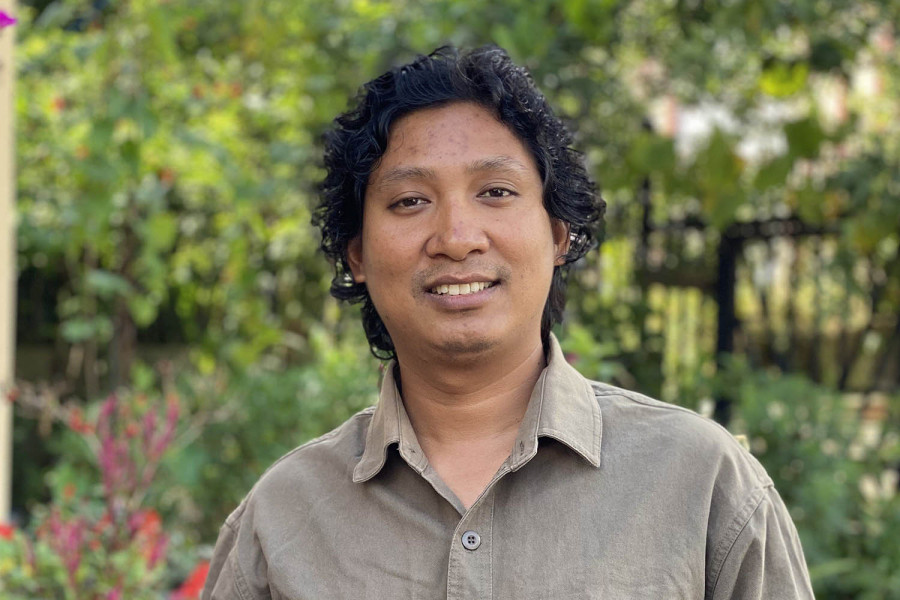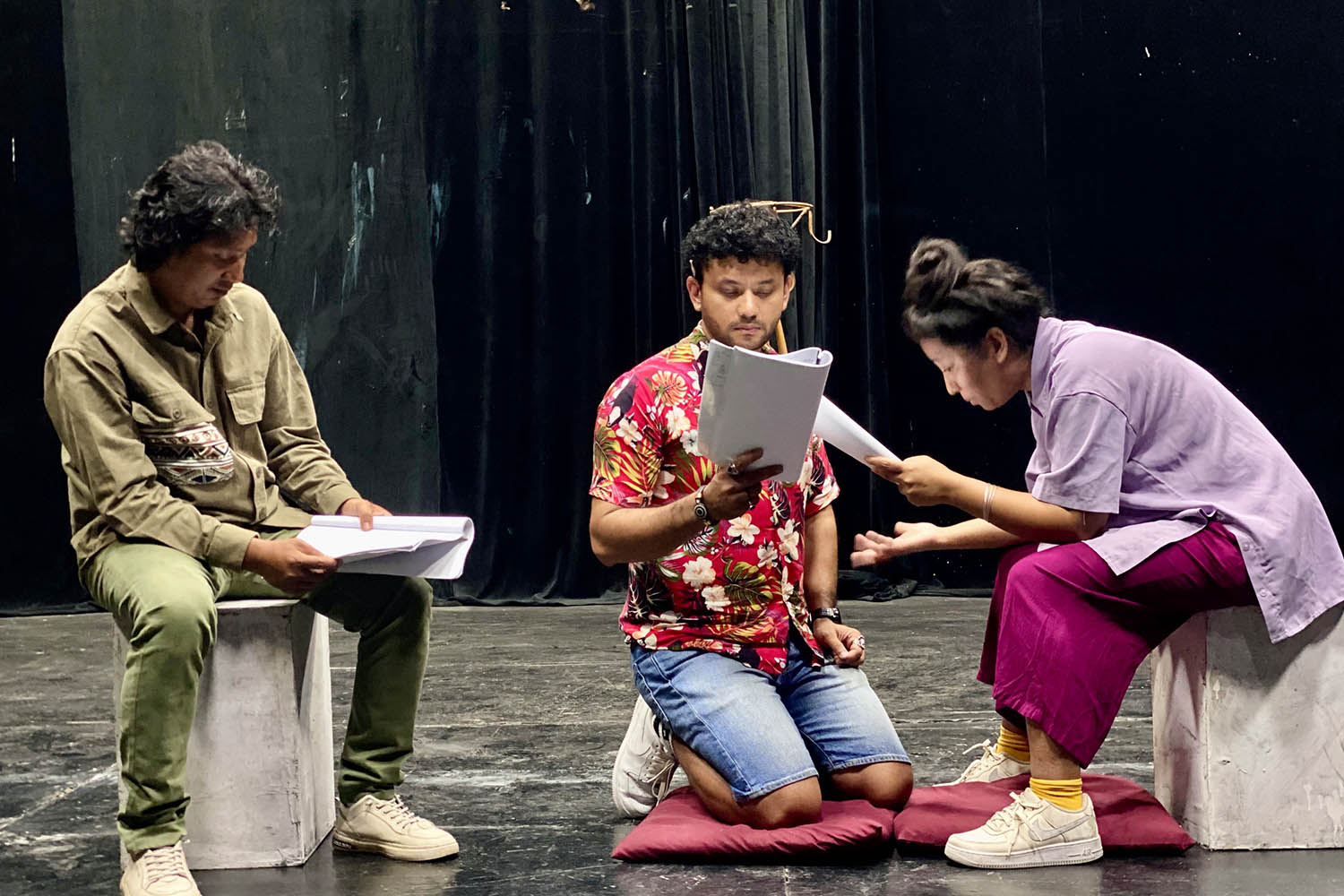Culture & Lifestyle
When literature lifts acting
Theatre artist and director Kedar Shrestha discusses storytelling, children’s literature, and the evolution of Nepali theatre.
Rishika Dhakal
Kedar Shrestha wears many hats. He is a theatre artist, children’s author, playwright, casting director, and filmmaker. To add to this list, he says, “I am also a storyteller.”
Shrestha was born in Dhading and educated in Kathmandu. While studying for SLC (now SEE), Dashain and Tihar brought him to Dhading, where he performed comedy skits for the village’s annual cultural programme. He grew up watching his uncles perform skits in the village but was only introduced to theatre after school. The Nepal Academy Hall organised a national theatre festival that featured plays from all over Nepal. “I once watched three plays daily for seven days,” says Shrestha.
Dissatisfied with Nepal Academy Hall’s technical limitations and its actors’ lack of professionalism, Shrestha began frequenting Gurukul instead. “I remember watching ‘Putali Ko Ghar’ (Doll’s House) thrice at Gurukul. I couldn’t fully grasp the story the first time because I was captivated by the stage lighting and the actors’ confidence and expressions,” Shrestha recalls.
On his second visit, Shrestha began noticing more about the acting, observing the performance’s entrances, exits, and other nuances. “It was on the third viewing that I understood the play’s philosophy, message, and deeper elements,” he says.
From that point, there was no turning back; Shrestha was hooked on theatre. “In college, I even started a kind of 'theatre activism' among my friends, urging them to join me in watching plays,” Shrestha recalls fondly.
The spark for Shrestha's transition from an audience member to a theatre artist was ignited when his classmate, Sanjog Thakuri, invited him to watch a play at Shaili Theatre. “We had an exam coming up, and just the day before my practical, I saw my teacher performing in the play,” he says.
In a playful moment, Shrestha said, “Sir, you’re an amazing actor.” To his surprise, the teacher mentioned another play that needed actors and asked if Shrestha was interested. “I agreed without hesitation, not even realising back then that theatre could be a career.”
Shrestha began his journey as a theatre artist at Shaili Theatre with Nabaraj Budhathoki’s play ‘Manus 1st play’. His performances in ‘Khabar Harayeko Chitti’ and ‘Jigri’, ‘Mann vs Matti’ , ‘Inspector General’, ‘Sarap Pareko Desh’, and ‘Ma Joker Banchu’, etc. made him feel like a theatre actor.
In 2013, after working as a coordinator at Shaili Theatre, Shrestha decided to forge his path and founded Theatre Mall, an independent theatre similar to Mandala Theatre. “Young people started the theatre—I was only about 25 or 26—so it became known as ‘kancha haru le kholeko natak ghar’ (the theatre started by the young ones),” he says.
Shrestha had many firsts in his new initiation, Theatre Mall. For instance, he directed ‘Upiya ko Nibandha’, his first professional play as a director. “This play was my debut in directing and playwriting," he says. The play was performed again in 2013 and 2016, featuring actors like Abhaya Baral, Laxmi Bardewa, Jiwan Bhattarai, and Bijay Tamrakar, among others.
Theatre Mall also served as a platform for aspiring directors. “With senior directors dominating the scene, younger enthusiasts, even those keen on directing, were limited to acting roles,” Shrestha explains. “I wanted to create a space where young people could explore directing, and as a result, many of Nepal’s now-established directors such as Ghanashyam Shrestha, Sudam KC, Anjan Pradeep, Ram KAC made their directorial debuts here,” he adds.

Shrestha’s passion for theatre grew from his interest in literature, poetry, and children’s literature. During his school days, he won numerous poetry competitions. “I used to read books, and I often thought, ‘This narrative could make a great play.’ That's why I often say if it weren't for poetry, I wouldn't be in the theatre.”
Shrestha’s friendship with children’s author Shanta Das Manandhar brought him into a community that shared his passion for children’s literature and theatre. Inspired by this connection, he went on to write several children’s books, including ‘Karesa Bari Ko Jadibuti’, ‘Ice Cream Sapana Bhayo’, ‘Guliyo Syaau’, and ‘Junu’, with the latter two translated into multiple languages. Shrestha’s commitment also extends to running children’s theatre.
“We need to establish children’s theatres as tools for supporting their personality development,” Shrestha says, highlighting theatre's unique impact on young audiences. To involve children in theatres, Shrestha and his team have been running a theatre workshop called ‘Little Theatre Garage’ for children aged between 6 and 14.
“When children participate in theatre or film, they begin to understand the philosophies and social dynamics of their society,” Shrestha explains. He notes that many child actors in Nepali films come from such workshops. “In Nepal, the role of a casting director is still rare, and mainstream films typically offer opportunities only to established professionals,” says Shrestha.
Films like ‘Aina Jhyaal Ko Putali’ and ‘Gaau Aayeko Bato’, shot in Sankhuwasabha and Bhojpur, respectively, cast and trained local children for key roles. Both films went on to represent Nepal at the Oscars.
“My other film, ‘Junu Ko Jutta,’ which was my debut as a director, was selected at the 66th edition of the International Short Film Festival Oberhausen, in Germany, where it won the Children’s Jury Award,” he says. It also won the Best Fiction Award in 2019 at the Kathmandu International Film Festival.
Shrestha plans to direct ‘Junu ko Jutta’, following the protagonist’s journey as an 8-year-old in one film and an 11 or 12-year-old in a sequel. “The aim is to complete the series over the next ten years. We’re currently working on another film, ‘Junu Ko Ribbon’,” he shares. ‘Junu Ko Jutta’ was selected for over 40 international film festivals across more than 20 countries and won over 20 awards.
“Whether in films or theatre, I aim to convey a simple message. I want my projects to be straightforward yet rich in literary and aesthetic value,” he says.
Shrestha reflects on the challenges he faced during his journey, “It took fifteen years of hard work to be able to call myself a theatre artist,” he shares. “Building an identity in any field is difficult. With experience, I’ve learned that consistency, continuity, and sustainability are the biggest hurdles.” Another challenge, he explains, is preserving theatre’s artistic and aesthetic quality as a literary form.
Shrestha advises careful consideration of their motives for those interested in theatre, noting that many join with dreams of becoming stars like Dayahang Rai or Saugat Malla. “Aspiring actors need to be clear on why they want to join—whether it’s for personal growth, fame, or joy,” he says. “If they’re committed to studying the art deeply, they’re welcome. It will be tough, but embracing those challenges is essential for a long-term career in theatre.”
Looking ahead, Shrestha is coordinating the third edition of the Nepal International Theatre Festival, where 18 plays selected from 115 entries worldwide will be staged at Mandala Theatre.
For his latest project, Shrestha is directing ‘DhukDhuki72MHz’, featuring lead actors Karma Shakya and Menuka Pradhan. “‘DhukDhuki72MHz’ will premiere on the day of Chhat festival and is scheduled to run for about 23 days,” he adds.




 15.47°C Kathmandu
15.47°C Kathmandu















